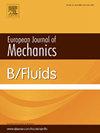斜面水驱油的粘指分析
IF 2.5
3区 工程技术
Q2 MECHANICS
引用次数: 0
摘要
粘指状是水驱油采油过程中常见的不稳定现象,极大地限制了采油效率。在这项研究中,我们提出了一种考虑到水油两相界面高度变化的水膜流动模型,从而能够计算和分析这种不稳定现象的触发机制和流动演化过程。我们从理论上推导出了水膜流动方程,可用于探索油置换过程中两相界面的流动演化过程。通过对二维流动方程进行数值求解,我们得到了行波剖面图,并发现两相界面的形态受平面倾斜角、毛细管数和两相液体密度比的显著影响。此外,我们还进行了线性稳定性分析和有限元数值模拟,考虑了较小的初始扰动,探讨了粘指现象的触发条件以及从平缓位移到不稳定流动的全过程。结果表明,当油的粘度与被驱动液体的粘度相差较小且密度较小时,被驱动液体前沿的移动接触线会更加稳定,从而提高水驱油过程的驱动效率。这些见解对提高采油效率具有重要的指导意义,我们也为实现这一目标提供了具体的工程建议。本文章由计算机程序翻译,如有差异,请以英文原文为准。
Viscous fingering analysis for water-drive oil in the inclined plane
Viscous fingering is a common instability event that occurs during the process of water-drive oil for oil recovery, significantly limiting the efficiency of oil extraction. In this study, we propose a film flow model that accounts for the variation in height at the water-oil two phase interface, enabling the calculation and analysis of the triggering mechanism and flow evolution process of this unstable phenomenon. We theoretically derive the equation of water film flow, which can be used to explore the flow evolution of the two-phase interface in the process of oil displacement. By numerically solving the two-dimensional flow equation, we obtain the traveling wave profile and find that the morphology of the two-phase interface is significantly affected by the plane’s inclined angle, capillary number and density ratio of the two-phase liquid. Furthermore, we perform linear stability analysis and finite element numerical simulation considering small initial disturbances to explore the triggering conditions of viscous fingering phenomenon and the full time from gentle displacement to unstable flow. The results reveal that the moving contact line of the driven liquid front is more stable when the viscosity of the oil is less different from the driven liquid and has a smaller density, thereby improving of the driving efficiency in the water-driven oil process. These insights have significant implications for guiding efforts to enhance oil recovery efficiency, and we provide concrete engineering suggestions to achieve this aim.
求助全文
通过发布文献求助,成功后即可免费获取论文全文。
去求助
来源期刊
CiteScore
5.90
自引率
3.80%
发文量
127
审稿时长
58 days
期刊介绍:
The European Journal of Mechanics - B/Fluids publishes papers in all fields of fluid mechanics. Although investigations in well-established areas are within the scope of the journal, recent developments and innovative ideas are particularly welcome. Theoretical, computational and experimental papers are equally welcome. Mathematical methods, be they deterministic or stochastic, analytical or numerical, will be accepted provided they serve to clarify some identifiable problems in fluid mechanics, and provided the significance of results is explained. Similarly, experimental papers must add physical insight in to the understanding of fluid mechanics.

 求助内容:
求助内容: 应助结果提醒方式:
应助结果提醒方式:


